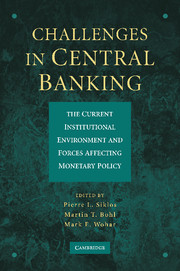 Challenges in Central Banking
Challenges in Central Banking Book contents
- Frontmatter
- Contents
- List of Tables, Figures, and Appendices
- List of Contributors
- Preface
- 1 The State of Play in Central Banking and the Challenges to Come
- PART I PAST, PRESENT, AND FUTURE IN THE CONDUCT OF MONETARY POLICY
- PART II THE SCOPE OF CENTRAL BANKING OPERATIONS AND CENTRAL BANK INDEPENDENCE
- PART III TRANSPARENCY AND GOVERNANCE IN CENTRAL BANKING
- 9 The Economic Impact of Central Bank Transparency: A Survey
- 10 How Central Banks Take Decisions: An Analysis of Monetary Policy Meetings
- 11 Institutional Rules and the Conduct of Monetary Policy: Does a Central Bank Need Governing Principles?
- Index
10 - How Central Banks Take Decisions: An Analysis of Monetary Policy Meetings
Published online by Cambridge University Press: 06 December 2010
- Frontmatter
- Contents
- List of Tables, Figures, and Appendices
- List of Contributors
- Preface
- 1 The State of Play in Central Banking and the Challenges to Come
- PART I PAST, PRESENT, AND FUTURE IN THE CONDUCT OF MONETARY POLICY
- PART II THE SCOPE OF CENTRAL BANKING OPERATIONS AND CENTRAL BANK INDEPENDENCE
- PART III TRANSPARENCY AND GOVERNANCE IN CENTRAL BANKING
- 9 The Economic Impact of Central Bank Transparency: A Survey
- 10 How Central Banks Take Decisions: An Analysis of Monetary Policy Meetings
- 11 Institutional Rules and the Conduct of Monetary Policy: Does a Central Bank Need Governing Principles?
- Index
Summary
Abstract
More than eighty central banks use a committee to take monetary policy decisions. The composition of the committee and the structure of the meeting can affect the quality of the decision making. In this chapter we review economical, experimental, sociological, and psychological studies to identify criteria for the optimal institutional setting of a monetary committee. These include the optimal size of the committee, measures to encourage independent thinking, a relatively informal structure of the meeting, and abilities to identify and evaluate individual members' performances. Using these criteria, we evaluate the composition and operation of monetary policy committees in more than forty central banks worldwide. Our findings indicate that, for example, the monetary policy committee of the Bank of England follows committee best practice, while the committee structure of other major central banks could be improved.
Introduction
In recent decades, central banks have undergone substantial transformations. One of the elements of the “quiet revolution” (Blinder 2004) in central banking has been a change in the way monetary policy decisions are taken: the “dictatorial central bank governor” of the past increasingly has been replaced by committees taking monetary policy decisions. Today, more than eighty central banks take monetary policy decisions in a committee. No country has ever replaced a monetary committee by a single decision maker (Mahadeva and Sterne 2000). In addition, central banks have become much more transparent (see van der Cruijsen and Eijffinger, this volume).
- Type
- Chapter
- Information
- Challenges in Central BankingThe Current Institutional Environment and Forces Affecting Monetary Policy, pp. 320 - 356Publisher: Cambridge University PressPrint publication year: 2010
- 18
- Cited by


